Sometimes you get goalie’d in this sport.
The Leafs absolutely dominated the run of play tonight — and ran into a hot goaltender. It’s happened a few times this season, but that’s no reason to ignore the positive signs that are going to lead to future success.
Auston Matthews was generating quality chances left and right. The top power-play unit was in constant motion, opening passing lanes all over the ice. William Nylander played over 20 minutes (again)!
The issue is that Igor Shesterkin one-upped them tonight. Hockey is an unfair game; the deserving team doesn’t win as often compared to other sports such as basketball or football.
That’s a lot of excuses tightly wrapped in a couple of paragraphs above, but the reason I bring them up is that the Leafs legitimately played a great game of hockey tonight. The fact that they lost 2-1 in overtime doesn’t change that for me, which will be reflected in the individual player grades.
Speaking of which, let’s get to it. Time for some Leafs Report Cards!
5 Stars
Auston Matthews (C, #34) — It’s electrifying watching Matthews when he’s on his A-game. He’s out there hounding for loose pucks on every shift and the second he gets his stick on one, he’s looking to attack the net. Matthews also did a great job of getting himself open without the puck, setting up shop at the top of the circle so he could uncork a few one-timers.
He finished the game with 16 shot attempts, nine of them coming from the slot. It’s beyond me how none of those found the back of the net, especially his last couple chances in 3-on-3 overtime, but those are the breaks sometimes. He had a few hard shots on the power play bounce off of Shesterkin’s glove and out, so you know he was close to beating the hot goalie.
It was also nice seeing what Toronto’s actual power-play configuration looks like with their best player back in action. We’ll touch on that more in the Mitch Marner section, but I like the different ways the Leafs were able to attack the defense on PP1, having players rotate into different spots to confuse opposing penalty killers and open up passing lanes.
Morgan Rielly (LD, #44) — We all know he’s a powerful skater; it’s why he’s able to activate into the rush so often to create scoring chances in transition. One thing I wanted to bring up is how he’s evolved as a playmaker over the years.
To help explain what I mean, let’s watch the following clip.
Young Rielly shoots that puck after gaining the zone and it probably gets gloved down for a whistle. Old Rielly wants the cross-seam pass, so he patiently waits for the play to develop before threading the backdoor pass to a teammate driving the net.
He’s always had elite physical gifts, but watching his mind catch up to his feet has been one of the more fun parts of evaluating his game offensively over the years. His ability to beat his man up the ice has a tonne of value in transition. What has even more value is how often he’s able to connect on passes through the slot.
Combine that elite transition play with elite passing and you have a player who’s going to contribute to a lot of goals, especially considering Rielly mostly plays with Toronto’s top six.
Jason Spezza (C, #19) — My biggest complaint lately has been the contrast between how phenomenal Jason Spezza is at generating passes through the slot — and the players who have actually been on the receiving end of those passes.
Once again tonight, Spezza was making some high-level passes in the offensive zone right through the teeth of the defense. He literally leads the NHL in this department thus far in 2021.
🍎🍎🍎 Watch….
3 of the top 5 players in Slot Pass Completions will be on the ice tonight in Toronto. pic.twitter.com/eFSPAX78Hs— Mike Kelly (@MikeKellyNHL) October 18, 2021
When most of those passes are landing on Wayne Simmonds’ stick, or Michael Amadio’s, or Pierre Engvall’s tonight, it feels like a massive opportunity cost. These are the highest value plays in hockey right now; a pass through the slot triples your expected shooting percentage.
Why the Leafs insist on playing Spezza more or less exclusively with their worst forwards at 5v5 is beyond me. It’s a waste of his passing prowess.
4 Stars
William Nylander (RW, #88) — Not only have I loved William Nylander’s play this season, I love that he’s finally getting rewarded by the coaching staff. He played 20:41 in this game and deservedly so. Sheldon Keefe was getting him some extra shifts at the end of periods and out of TV timeouts alongside Matthews and Marner.
Not that Nylander needs elite linemates to generate chances. He did the bulk of the puck transporting for Toronto’s second line on Monday night, dangling his way through defenders to gain the zone and create some high-percentage opportunities off the rush. Nylander was also able to sneak behind the defense for a breakaway on the power play, ringing one off the bar after a nice behind-the-back pass from Matthews to set him free.
If Nylander keeps playing at this level and continues to get the ice time commensurate with his on-ice value, I don’t see why he shouldn’t be able to shatter his career highs and finally become the point per game forward his talent suggests he should be.
Travis Dermott (RD, #23) — The biggest concern with a Sandin-Dermott pair is how much you trust them defensively. Can we really expect Dermott to defend 2v1s or 4v2s as well as TJ Brodie has in the past?
Damn, maybe we can.
If there’s one play Dermott has shown an affinity for over the years, it’s timing his slide defensively to take away that pass through the middle of the ice, which we already discussed is the most valuable play in hockey these days. He also did a solid job defending the cycle, using his body to “box out” opposing forwards driving towards the net.
When it comes to assessing Dermott’s play, I’ve actually been most impressed with him on the offensive side of the puck. Over the last few years, the Leafs haven’t allowed many chances with Dermott on the ice, but they’ve also struggled to generate chances. A lot of that has come down to #23’s inability to make plays consistently in the offensive zone.
Early on this season, he’s been making plays. Dermott looks much more comfortable activating into the play when the situation calls for it, keeping pucks alive when they rim around to him and even getting himself into some dangerous shooting locations when the opposing defense loses him in coverage.
This is the Travis Dermott I’ve been waiting to see, so here’s hoping he can continue his strong play at 5v5.
Mitch Marner (RW, #16) — I find it funny how most Leafs fans can admit Matthews had an excellent game despite picking up zero points, but immediately pick up their pitchforks when Marner fails to produce. Maybe it’s just something I need to get used to when I doomscroll through Leafs Twitter these days.
For my money, Marner was dynamic as a passer this evening. He found Matthews in Grade-A shooting locations multiple times at 5v5. Marner also provides some strong defensive play both at even strength and the penalty kill. Let’s face it, though, most of us are more interested in how he’s handling his new role on the power play.
Tonight was our first official look at PP1 for Toronto and there were some very positive signs. Marner did his best to fill in the open space, getting himself to a spot where the four penalty killers weren’t standing. Sometimes that meant #16 dropping down to the goal line as a passing outlet. Other times it meant standing almost on top of Matthews looking for a quick one-timer.
I won’t say it’s my favourite play, but it’s a look we’ve seen a lot from the new PP configuration starting in the preseason.
That leads me to my next point. Marner looked his most dangerous on the power play when he rolled up high to receive a pass and then skate downhill towards the net.
This play probably works better if Matthews and Nylander are on their one-timer sides, but it’s the overall concept that I love. Marner gets to scan the defense with plenty of room in the middle of the ice and choose who he wants to distribute to, with his options being:
- A one-timer for Matthews
- A one-timer for Nylander
- A quick shot for a Tavares deflection
- Resetting the play to Rielly behind him
The Leafs tried this a bunch of times in the preseason, so you know it’s a play they’ve designed for Marner. If opposing PKs decide to chase him up high in the zone, it’ll open up more space for his teammates to get open in the high danger areas. If they leave Marner wide open at the top, he has all kinds of time and space to make a play.
We’ll get more looks at how the Leafs attempt to creatively deploy Marner on the power play throughout the 82-game season, but consider me thoroughly impressed with the early returns.
3 Stars
Nylander’s Linemates — This isn’t to take anything away from Michael Bunting or John Tavares, both of whom played well tonight. It’s more an indication that Nylander was the one driving the bus at 5v5, particularly in transition.
Bunting did exactly what you’d expect him to: getting his nose dirty in the tough areas of the ice, which is where how he picked up his second goal of the season. What can I say? Good things happen when you go to the net.
Tavares made a few subtle-but-fantastic passes tonight. One of those came on the power play, one-touching a cross-crease pass to Nylander on the left flank, who wasn’t able to fully connect on the shot. Tavares also chipped the puck up to Nylander for a breakaway at 5-on-5. Now, I still think there’s another gear Tavares can reach offensively, but we’re starting to see more and more flashes as the season progresses.
Spezza’s Linemates — This is an even starker contrast than the one between Nylander and his linemates tonight. Spezza was the one doing everything for his line in this game, advancing the puck up the ice with possession, making creative plays at the line to gain the zone, and generating dangerous chances offensively with his passing.
That said, Wayne Simmonds had a few moments in this game, getting himself to the net front on a few separate occasions for some Grade-A chances in tight. The issue is that he and Pierre Engvall just couldn’t continue the passing sequences Spezza was trying to start up.
For example, Simmonds got the puck on a 4v2 rush and chipped it into the corner. Engvall was making similarly baffling decisions with the puck in the offensive zone, at one point skating the puck out of the zone when there was plenty of room to attack the net. He has this weird tendency to make more plays towards his own net than the opponent’s, which is part of the reason he drives us all crazy sometimes, Keefe included.
Rasmus Sandin (LW, #38) — For once there won’t be Rasmus Sandin hyperbole tonight, which feels weird. I thought he was okay, just okay (good one Randy). He got caught a few times defensively off the rush, forcing his partner to bail him out.
Sandin helped make up for it by providing value offensively and on the breakout. He’s so good at finding open ice without the puck, using his edges to quickly shed his man and sneak into open space out of seemingly nowhere. He’s also shown an affinity for walking the line and getting pucks through traffic, which is always a valuable trait for a defenseman.
Jack Campbell (G, #36) — This is a weird one to grade.
In the first period, Campbell let a few pucks behind him. Alexis Lafreni??re squeezed one under his armpit and almost past the goal line, only for Jake Muzzin to clear it at the last second.
Later in the game, Campbell stood on his head. Just look at some of these saves if you have the time.
This entire clip feels like it should come with a health warning pic.twitter.com/rzJSyrwfjZ
— Pete Blackburn (@PeteBlackburn) October 19, 2021
I’ve seen a bunch of fans arguing he was the most impressive Leaf tonight, which might be a bit of recency bias, but I can certainly understand the sentiment.
One final thing I wanted to bring up on Campbell was the goal he allowed to Zibanejad, but more specifically, Toronto’s netminder starting the sequence behind the net that led to the turnover immediately before the goal.
The main thing I've noticed with this puck retrieval tracking is how many botched exits start with the goalie. Also noticing some games where neither goalie plays the puck much (Florida-Pitt the other night) & others where it's almost every dump-in.
— Corey Sznajder (@ShutdownLine) October 19, 2021
Corey Sznajder watches (and tracks) an ungodly amount of hockey, so when he points out how many botched breakouts start with the goalie, he’s probably onto something. I know I’m going to be watching dump-ins a lot closer than I usually do moving forward.
2 Stars
The Muzzin-Holl Pair — Poor Jake Muzzin just hasn’t looked like himself to start the 2021 season. Maybe some of that is the nagging lower-body injury he suffered in the playoffs. Maybe it’s just a veteran coming out of the gates slow, but he’s been on the ice for all of the goals Toronto has surrendered at 5v5 so far this season.
Are goal metrics a reliable measure? Hell no, but that’s still not a great trend for your shutdown pair. His partner, Justin Holl, actually looked better to my eye tonight. He made a few nice stops in 1v1 rush defense, had a good stick at the blue line on the PK, and even delivered a momentum-swinging hit on Ryan Reaves.
Both defenders struggled to read plays quick enough in the offensive zone; Holl took too long to find Matthews wide open on the right dot and put the pass in his feet, whereas Muzzin had a 4v2 opportunity where he failed to complete the next pass.
Needless to say, we’ve come to expect more from this pairing.
The Third Line — The fact that most people thought this was one of Alex Kerfoot‘s better games of the season and he still ended up deep in the red statistically, even relative to his own linemates (33% CF, 36% xGF, negative Game Score), might tell us something. He actually registered a few shots tonight, but he wasn’t driving play up the ice with his speed as much as you’d like to see.
I came away much more impressed with David Kampf, at least on the defensive side of the puck. Including tonight’s game, the Leafs have controlled 57 percent of the shots and 56 percent of the expected goals at 5v5 with Kampf on the ice this season despite the fact that he’s only received three offensive zone starts compared to 28 defensive zone starts. Kampf has also won 65 percent of his faceoffs four games into the season.
He’s Kyle Dubas’ Marcus Kruger.
Last and least is Ondrej Kase, who’s been quiet offensively compared to what we saw in the preseason. I could pull up any chart out there to prove his consistent ability over the years to advance the puck up the ice and generate offense at a top-six rate. Those are facts across a large sample.
In the small sample of tonight’s game (and the three preceding it), he hasn’t looked nearly as dangerous with the puck on his stick in the offensive zone. We should expect much more from him considering his track record at the NHL level.
TJ Brodie (RD, #78) — This isn’t the TJ Brodie I remember. He’s missing basic passes on the breakout, panicking under pressure in the defensive zone, and seemingly turning the puck over on every puck touch in the offensive zone.
Much like Kase, he’s a much better player than he’s shown lately.
1 Star
Nick Ritchie (LW, #20) — I was listening closely to some of Sheldon Keefe’s quotes about Nick Ritchie heading into this game.
“When he gets the puck, for a big guy, very often the next play is going onto one of our sticks. That is an underrated but extremely important piece to play with good players…he consistently is moving the chains.”
I didn’t see any of that tonight, and frankly, haven’t seen much of it all season. I find that he’s often a half-second too late before making the next pass to Matthews or Marner, failing to keep up with how fast they can think the game. I’m also disappointed in his forechecking. You’d think he would be an intimidating presence with the hit totals he racks up, but most of those come well after the puck has been moved.
If he keeps playing like this, it won’t be long before he falls out of favour in Toronto’s top six. Star players don’t like playing alongside linemates who make their lives more difficult.
Heat Map
Here’s a quick look at where each team’s shots were coming from at even strength, courtesy of Natural Stat Trick.
The effect looks even more pronounced if you include shots on the power play.
The Leafs somehow lost this game despite controlling the majority of shots and chances. That’s hockey for you.
Game Score
Game score is a metric developed by The Athletic’s Dom Luszczyszyn to measure single-game performance. You can read more about it here.
Tweets of the Night
I don't want to jump to conclusions here, but I'm starting to think Matthews is an upgrade over Amadio
— Kevin Papetti (@KPapetti) October 18, 2021
Big if true.
Few will admit this but Spezza would be better than Marner on PP1
— J (@Account4hockey) October 18, 2021
A legitimate shot threat who can also thread cross-seam passes at an elite level? Maybe this isn’t as crazy as it sounds.
john tavares said “relaxed dress code? let me just untuck this shirt real quick, oh boy do I feel casual” pic.twitter.com/49n5EIjoth
— liz 🦇 (@yanoforsure) October 18, 2021
Honestly, I’m surprised he didn’t have a matching vest and tie.
If there's anyone to analyze a period where the Rangers get out-attempted 26-8 / outshot 17-2 and have goaltending heroics to keep them in the game, it's Henrik Lundqvist
— Shayna (@hayyyshayyy) October 19, 2021
“Same shit, different year.”
1. Brodie is just tired, wants the rest and gets an icing. The ensuing Ozone faceoff (with disjointed lines stuck on ice) contributes to the spike in scoring.
2. The faceoff eliminates the effect and Brodie is encouraged to get an icing to delete that high scoring state.
— Earl Schwartz (@EarlSchwartz27) October 19, 2021
This tidbit from Earl Schawrtz really made me think. Considering how panicked Brodie looked with the puck on his stick tonight, I’m not sure if he was consciously thinking about the percentages here.
That doesn’t change the fact that going off the glass and out can sometimes be a good play that improves your chances of winning, even though most hockey coaches are convinced that’s the case way more often than it actually is.



![Sheldon Keefe on the Maple Leafs’ struggling power play: “[We’ve scored] one out of 11 high-danger chances in tight to the net… We have been in those spots and haven’t converted” Sheldon Keefe, playoff press conference](https://mapleleafshotstove.com/wp-content/uploads/2024/04/keefe-pc-game-3-218x150.jpg)

![Jim Montgomery Post Game, Bruins 4 vs. Leafs 2: “[Marchand] still manages to get under people’s skin, yet he doesn’t cross the line” Jim Montgomery, Boston Bruins post game](https://mapleleafshotstove.com/wp-content/uploads/2024/04/jim-monty-pg-to-218x150.jpg)



















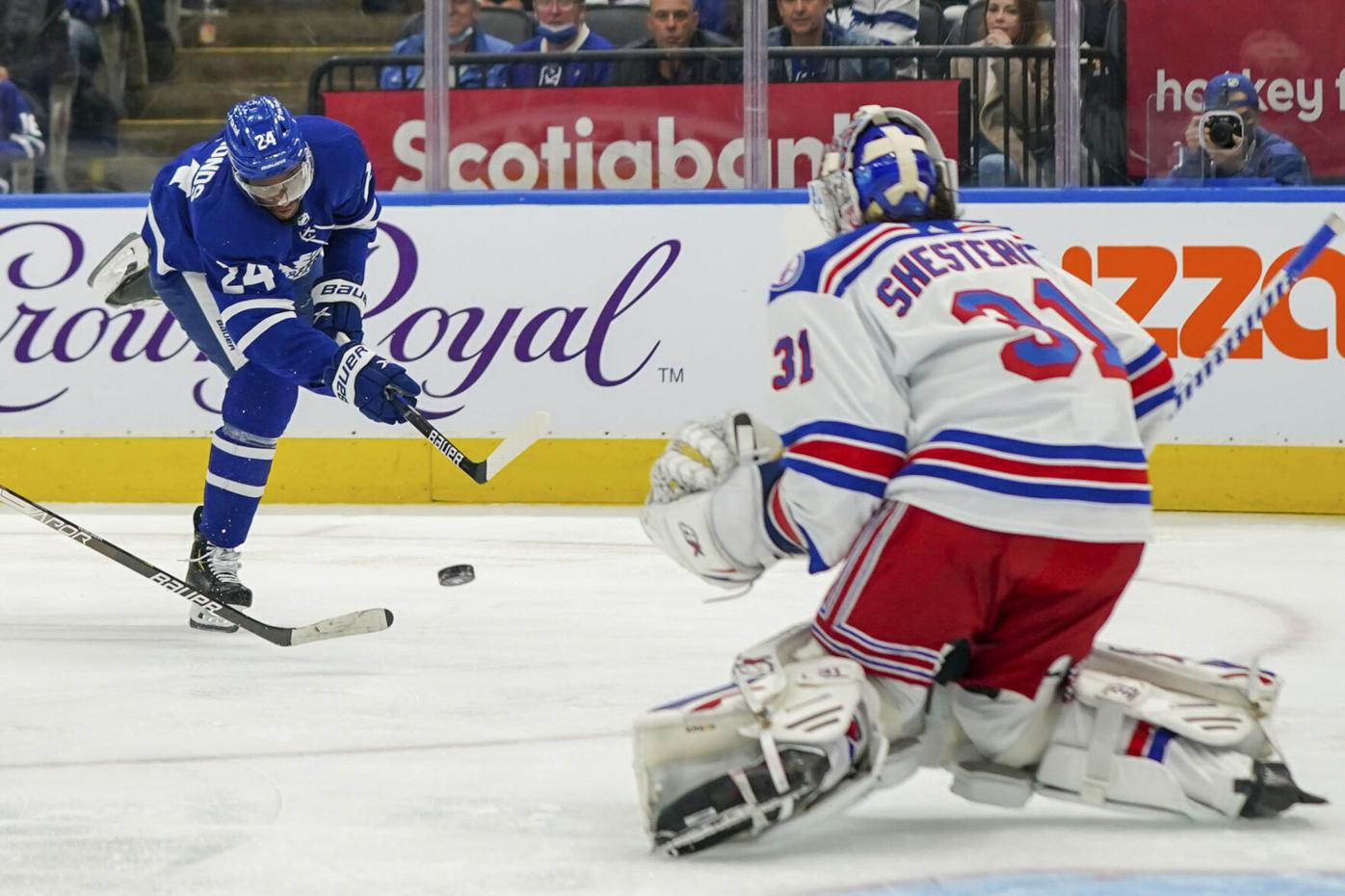
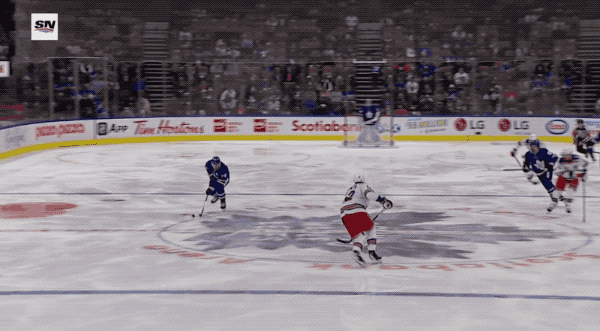
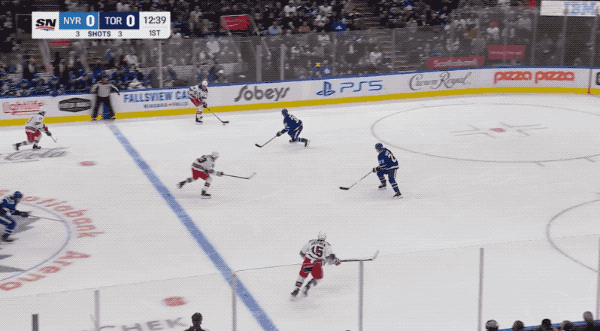
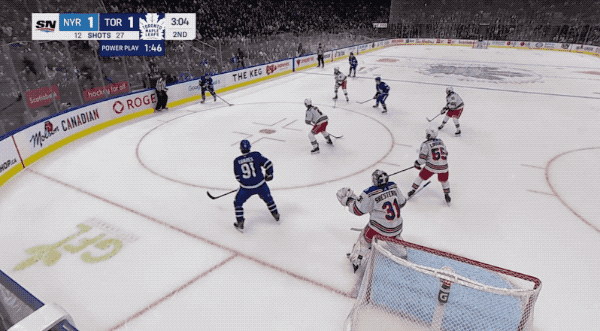
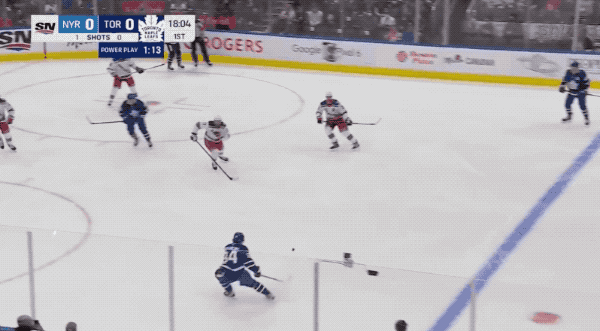
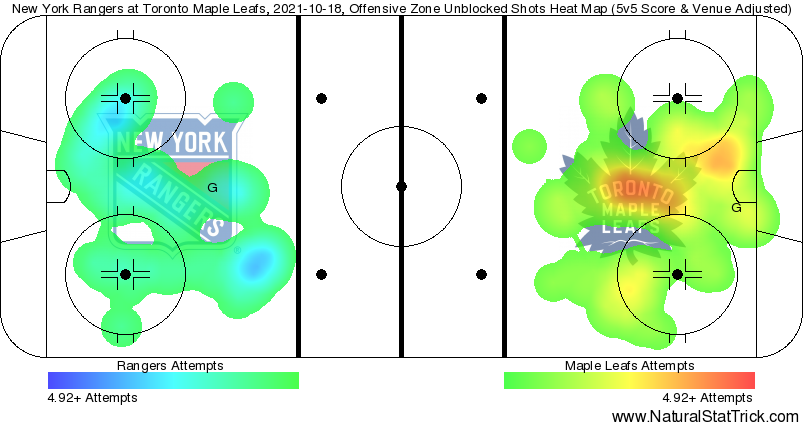
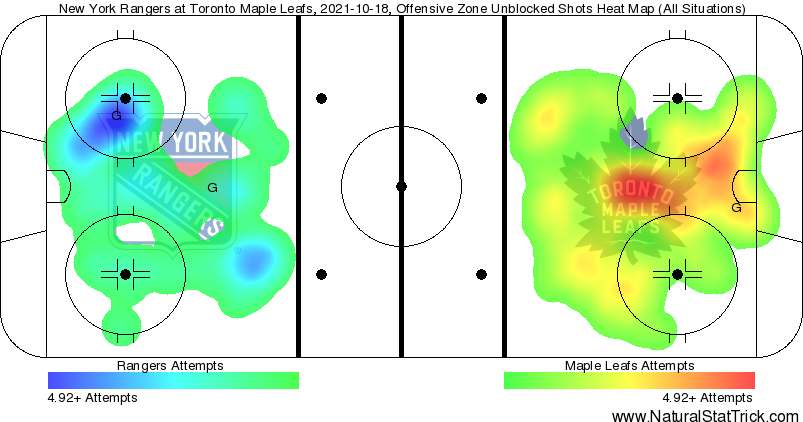
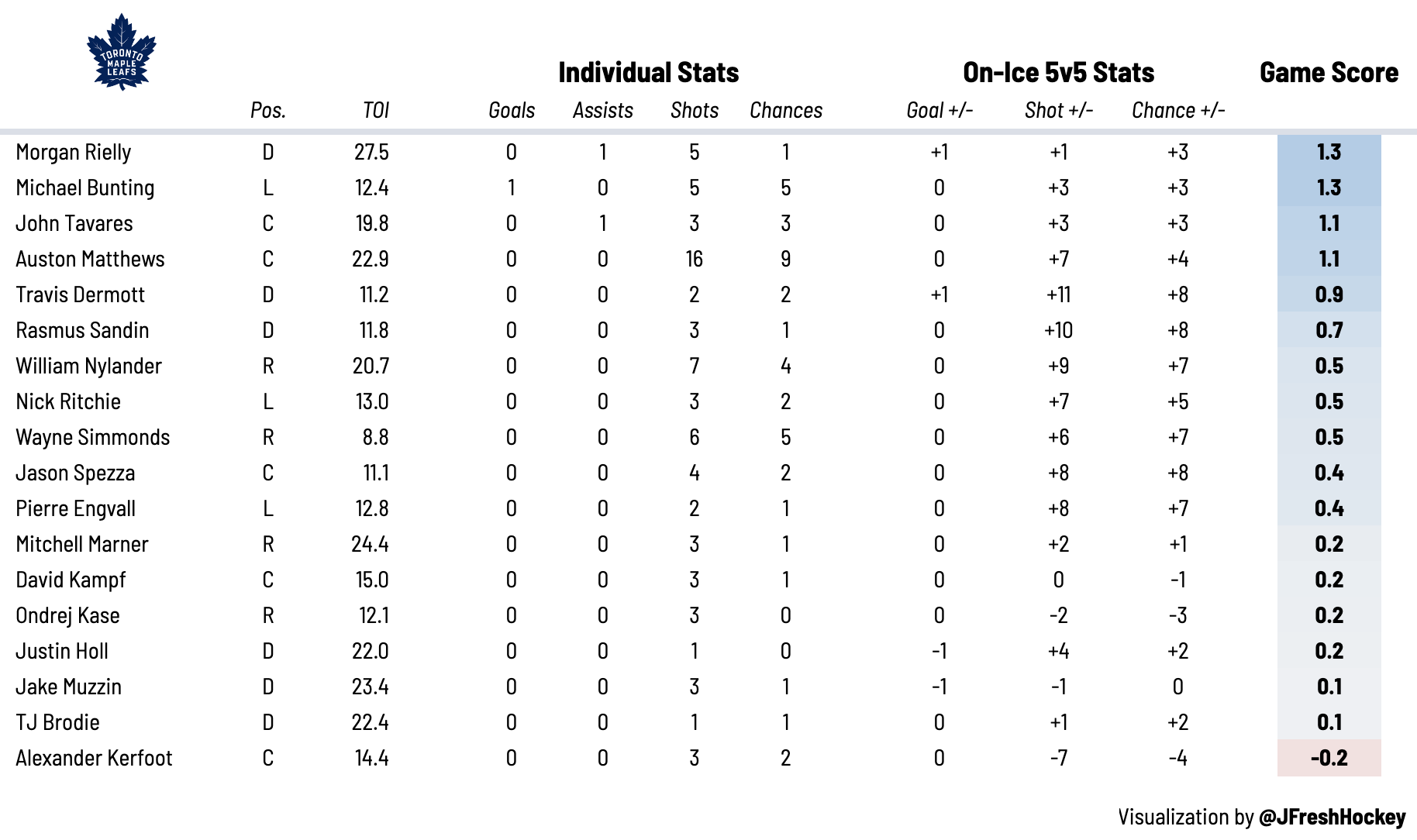




![Sheldon Keefe on the Maple Leafs’ struggling power play: “[We’ve scored] one out of 11 high-danger chances in tight to the net… We have been in those spots and haven’t converted” Sheldon Keefe, playoff press conference](https://mapleleafshotstove.com/wp-content/uploads/2024/04/keefe-pc-game-3-100x70.jpg)



![Jim Montgomery Post Game, Bruins 4 vs. Leafs 2: “[Marchand] still manages to get under people’s skin, yet he doesn’t cross the line” Jim Montgomery, Boston Bruins post game](https://mapleleafshotstove.com/wp-content/uploads/2024/04/jim-monty-pg-to-100x70.jpg)
